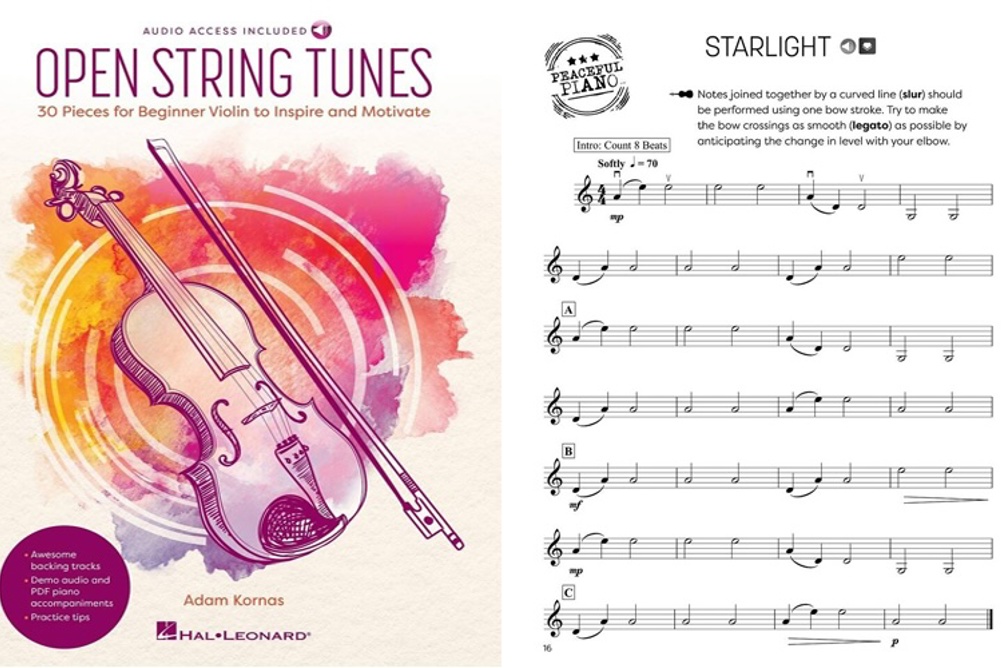
New to the market in 2024 is this collection of 30 pieces for the beginner violin student, each with a specially written backing-track in a variety of popular contemporary styles. The title may give the impression that these pieces are for the first lessons of the typical seven- or eight-year-old beginner, and the first 11 would certainly fit that mould, starting with pizzicato and then introducing long arco sounds, staccato and string crossing. After that, though, the pieces incorporate more sophisticated bowing techniques like hooking, together with more advanced rhythmic concepts like compound time and syncopation. Listening to the moody or edgy backing-tracks which call on gaming, epic movie and EDM styles, it becomes clear that the book is aimed more at older children and teenagers as a collection of enjoyable bowing and rhythm studies (up to Grade 2 level) which could also stand up in performance.
Most methods and collections for beginners tend to fold in more sophisticated rhythms and bowing techniques once learners have started using their left hand along with basic bowing, because which learner doesn't want to play a recognisable tune with a few pitches? However, there is something pure about focusing on bowing and rhythms just using open strings. If you teach it right, the student will have the chance to hone their tone and articulation as well as develop a solid internal pulse from playing with the backing-tracks. Peppered among the practice tips for each piece are Paul Rolland-type suggestions, encouraging the use of balance and movement to enhance tone, or walking and playing to develop independence and freedom in the bowing arm.
This collection does not claim to be a method, but there is clear progression in what skills and knowledge are needed to play each successive piece. The contents page neatly summarises which elements are introduced in which piece, using a table that includes graphics of the rhythms as well as columns for ‘style’ and ‘technique’. Added to that are the clear and organised compositions: most of these pieces have two musical ideas for the violinist, written into familiar ABA forms and the like. This allows for plenty of repetition together with a sense of structure, meaning that the student can focus on one or two technical points and rhythms as well as applying block dynamics and, later in the collection, some shaping.
As a product, the book is simple and appealing to look at and read from, with good quality printing and layout, modern fonts and an attractive front cover. The backing-tracks are all digitally made, and while that could have been disappointing, the composer has made a virtue out of it by employing so many different contemporary styles. In addition to the ones already mentioned we have funk, ‘nu-disco’, ‘peaceful piano’, hip-hop, and even a march and a waltz. Helpfully, there are piano accompaniments to download as PDFs, but in most settings the backing-tracks, available to stream or download from the Hal Leonard website, will be more than suitable. These days teachers rely on backing-tracks more and more so that they can be free to coach students as they play; but also, when presenting beginner string players next to the school rock band (or whatever it may be), some assistance in the form of a modern and compelling accompaniment is usually much appreciated.
The biggest question around this book is whether teachers will find enough benefit in using open string studies to carve out the time for it alongside other learning. In terms of sight-reading, it has limited benefits, but should at least instil more confidence in students who struggle in that area. And there's a strong argument for pointing attention purely at bowing while giving pupils a rest from grappling with note-reading and left-hand coordination. Whether or not students up to Grade 2 or 3 level will engage with open string studies is another question, and largely down to the teacher's conviction that it is important. These are decent performance pieces together with the backing-tracks and should be quick to teach, which gives them a good chance.
Will it be a go-to resource that teachers will use in every lesson? The answer to that is probably not, but it is worth investing some time in. I would give it a worthy recommendation for students to purchase as supplementary material.
Open String Tunes
Adam Kornas
Hal Leonard
ISBN 9781705179642
£6.99
Open String Tunes | Musicroom.com




